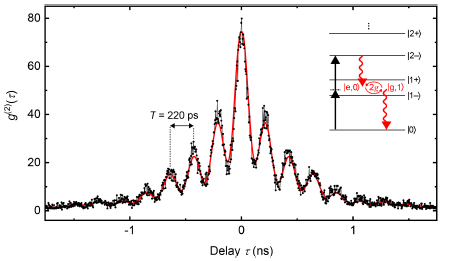A gated quantum dot stronglycoupled to an optical microcavity.
QQ Academic Group: 1092348845
Detailed
The strong coupling mechanism of cavity quantum electrodynamics (cavity QED) represents the photo-material interaction at the full quantum level. Adding a single photon changes the resonant frequency, resulting in far-reaching nonlinearities. Cavity QED is a test platform for quantum optics and is the basis for photon-photons and atom-atomic entanglement gates. The success of cavity QED has a revolutionary effect at microwave frequencies. At light frequencies, the door may be faster. Photons can travel a long distance and are easily detected. After pioneering work on monoatoms, solid state implementations using semiconductor quantum dots have emerged.
The Daniel Najer research team at the University of Basel introduced a gated, ultra-low loss, frequency-adjustable microcavity device. The gate allows the quantum dot charge and its resonant frequency to be electrically controlled. It is essential that they eliminate the intracavity feed. Even in the microcavity, the linewidth of the quantum dots is close to the radiation limit. In addition to avoiding crossovers that are very obvious in the spectrum, the researchers also observed a clear coherent exchange (vacuum rabbi oscillation) of a single energy quantum between the "atoms" and the cavity in the time domain. Decoherence is mainly produced by atomic and photon loss channels. The coherence is used to detect transitions between single-shot and double-excitation photon-atomic systems by photon statistical spectroscopy.
The Daniel Najer research team at the University of Basel introduced a gated, ultra-low loss, frequency-adjustable microcavity device. The gate allows the quantum dot charge and its resonant frequency to be electrically controlled. It is essential that they eliminate the intracavity feed. Even in the microcavity, the linewidth of the quantum dots is close to the radiation limit. In addition to avoiding crossovers that are very obvious in the spectrum, the researchers also observed a clear coherent exchange (vacuum rabbi oscillation) of a single energy quantum between the "atoms" and the cavity in the time domain. Decoherence is mainly produced by atomic and photon loss channels. The coherence is used to detect transitions between single-shot and double-excitation photon-atomic systems by photon statistical spectroscopy.

Najer, D. et al. A gated quantum dot stronglycoupled to an optical microcavity. Nature 2019.
DOI: 10.1038/s41586-019-1709-y
https://www.nature.com/articles/s41586-019-1709-y
source from http://www.nanoer.net
- Previous: High performance MQW p
- Next: 1


 About us
About us